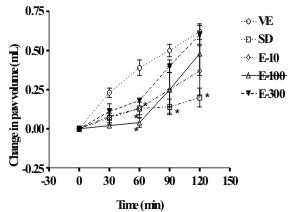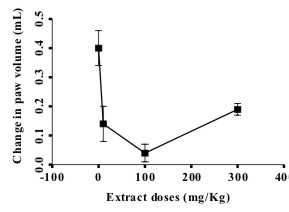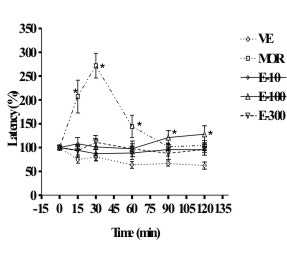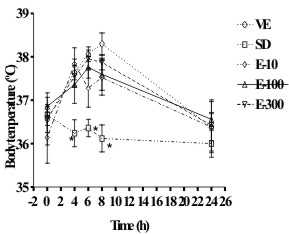Investigación Clínica
versión impresa ISSN 0535-5133
Invest. clín v.45 n.4 Maracaibo dic. 2004
Anti-inflammatory, antinociceptive,
and antipyretic effects of Lantana trifolia Linnaeus in experimental animals.
Bercy Uzcátegui1, Dinorah Ávila1, Heberto Suárez-Roca2, Luis Quintero2, José Ortega1 y Beatriz González1.
1Natural Products Laboratory, Faculty of Sciences, University of Zulia and 2Pharmacology Section, Instituto de Investigaciones Clínicas, Faculty of Medicine. University of Zulia, Maracaibo, Venezuela. E-mail: dinavila@cantv.net; hsuarezroca@yahoo.com
Abstract. Lantana trifolia L. (Verbenaceae) is traditionally used as an anti-inflammatory medicinal plant in Venezuela. The methanol extract of the aerial parts of L. trifolia were assessed for the anti-inflammatory, anti-nociceptive and anti-pyretic properties. The extract produced an inhibition of carrageenan-induced edema in the rat paw over a dose range of 10-300 mg/kg i.p.; the dose-response curve was bell-shaped with a maximal effect at 100 mg/kg. The extract also produced a small but significant increase in the response latency of rats subjected to the hot plate, a thermal pain test that only detects analgesia by high-efficacy agents. The extract did not exhibit antipyretic activity. Thus, the L. trifolia extract could have therapeutically relevant anti-inflammatory and analgesic properties in humans.
Key words: Lantana trifolia, Verbenaceae, anti-inflammatory activity, antinociceptive activity.
Efecto antiinflamatorio, antinociceptivo y antipirético de Lantana trifolia Linnaeus en animales de experimentación.
Resumen. Lantana trifolia Linnaeus (Verbenaceae) es tradicionalmente utilizada en Venezuela como una planta medicinal antiinflamatoria. Nosotros indagamos si el extracto metanólico de la parte aérea de L. trifolia posee propiedades antiinflamatoria, antinociceptiva y antipirética. El extracto produjo inhibición del edema inducido por carragenina en la pata trasera derecha de las ratas, en dosis de 10-300 mg/Kg de peso del animal., administradas vía i.p. La curva dosis-respuesta exhibe un máximo a la dosis de 100 mg/Kg. El extracto también produjo un leve pero significativo incremento en la respuesta de latencia de las ratas sometidas al plato caliente, una prueba que sólo detecta analgesia en agentes altamente eficaces. El extracto no exhibió actividad antipirética. El extracto de L. trifolia pudiera tener propiedades terapéuticas antiinflamatorias y analgésicas relevantes en humanos.
Palabras clave: Lantana trifolia, Verbenaceae, actividad antiinflamatoria, actividad antinociceptiva.
Corrresponding Author: Dinorah Avila, PO Box 10496. Maracaibo, Venezuela. Telfax: 58261-7987704. E-mail: dinavila@cantv.net
Recceived: 14-01-2004. Accepted: 08-05-2004.
INTRODUCTION
Medicinal plants are an important source of new chemical substances with potential therapeutic effects. The research into plants with alleged folklore use as pain relievers should therefore be viewed as a fruitful and logical strategy in the search of new analgesic drugs. In addition, although there is a wide availability of clinically useful anti-inflammatory and analgesic drugs, a continuing search for new effective agents with less unwanted side-effects remains vital.
Many genus belonging to the family Verbenaceae were demonstrated to have diverse pharmacological properties (1-6) among which, the pharmacological and chemical properties of the genus Lantana has been extensively studied. For example, extracts of Lantana camara has the notoriety of causing hepatotoxicity and photosensitization in grazing animals (7,8) however the plant has also the reputation of being used in traditional medicine (9). Some metabolites isolated from their leaves are potential antitumor agents (10) and others have antithrombin activity (11). On the other hand, Lantana trifolia extracts produce bronchodilatation of isolated guinea pig trachea (12) and the leaves contain an antimicrobial active flavonoid (13). L. trifolia is commonly called as “cariaquito morado”, and is used widely for its anti-inflammatory properties; in fact, the aerial parts are used for rheumatism (14, 15). Since there is no scientific evidence in support of this therapeutic use, extracts obtained from the aerial parts of Lantana trifolia were subjected to pharmacological screening. Thus, we have evaluated the anti-inflammatory and analgesic properties of Lantana trifolia extracts in rats using behavioral tests that have been previously validated to detect analgesic, anti-inflammatory and anti-pyretic activity in rodents.
MATERIALS AND METHODS
Plant material
Two hundred plants (50 cm high) of L. trifolia were commercially purchased from a local shop in Maracaibo, Venezuela, in July 1998. A voucher specimen has been deposited in the Herbarium of the Biology Department at Faculty of Science of Zulia University, under Nº 3724; collection of Dr. Miguel Pietrangeli.
Preparation of extract
Dried and powdered aerial parts (400 g) were extracted with petroleum ether by means of soxhlet, followed by an exhaustive extraction with methanol at room temperature. A dark residue was obtained with a yield of 3.5% (w/w).
Animals
Male Sprague-Dawley rats (250-300 g), purchased from the Instituto Venezolano de Investigaciones Científicas, were used for the experiments. The animals were divided into five groups containing six rats each. The rats were maintained under standard animal housing conditions and had access to standard laboratory food and water ad libitum. This protocol was accepted by the Technical Committee of the Faculty of Sciences.
Anti-inflammatory activity
An acute cutaneous inflammation was induced in the hind-paw of the rats using the procedure described by Winter and col. (16). Briefly, the phlogistic agent carrageenan (1.0%, 0.05 mL) was injected into the plantar surface of the right hind-paw, and the same volume of sterile saline solution (0.9%) was injected into the left hind paw. The paw volume was measured at 30, 60, 90 and 120 min using a plethismometer (Ugo Basile, Italy). The difference in volume between left and right hind paws was taken as a measure of edema. The positive control compound sodium diclofenac (30 mg/kg) and the plant extract (10, 100, 300 mg/kg) were administered intraperitoneally 30 min before the administration of carrageenan.
Antinociceptive acitivity
The hot plate test at 52.5 ± 0.5°C (IITC, Inc., California USA) was used as previously described by Woolfe and McDonald (17). The opioid analgesic, morphine chlorhydrate (7.5 mg/kg, i.p) was used as a positive control for the test. Five groups of rats were treated i.p. with different doses (10, 100, 300 mg/kg) of the extract and with positive and negative controls. The time elapse from the placement of the animal on the hot plate until the licking of the hind-paw was taken as the response latency. The response latency was measured just prior to drug administration and then 15, 30, 60, 90 and 120 min later.
Antipyretic activity
The method of Loux was followed to induce pyrexia in the rats by injecting 20% aqueous suspension of brewer’s yeast (10 mL/Kg, i.p.) in the animals back below the nape (18). Animals were then fasted for the duration of the experiment, water being made available ad libitum. Rectal temperatures taken 1 h prior to drug administration in fevered animals served as a pre-drug control. Plant extract (10, 100, 300 mg/kg), saline as vehicle control (0.9%, 0.05 mL), and sodium diclofenac (30 mg/kg) were given i.p. 3 h after the yeast injection and temperatures were recorded 1, 4, 6, 8 and 24 h after their administration. Additional control temperatures were taken 24 h after yeast injection to determine the pyretic response.
Statistical analysis
Differences between control and treated groups were tested for statistical significance by one-way ANOVA followed by multiple range Duncan’s test. A probability of P<0.05 was chosen as the criterion of statistical significance.
RESULTS
Anti-inflammatory activity
The methanol extract reduced the carrageenan-induced paw edema. Every dose of extract exhibited a significant (P < 0.05) effect at 60 min after the administration (Fig. 1). The analysis of the anti-inflammatory effect at 60 min after the administration of the extract reveals that the dose-response curve was bell-shaped (Fig. 2). Indeed, the intermediate dose (100 mg/kg) produced a maximal anti-inflammatory effect whose magnitude was similar to that produced by the standard anti-inflammatory agent sodium diclofenac. This effect significantly decreases at 300 mg/kg of the extract.
Antinociceptive activity
The hot plate test detected a very week analgesic effect for the extract. This slight effect was observed between 90 and 120 min after the administration of a dose of 100 mg/kg of the extract, when the effect of the positive control compound (morphine chlorhydrate) had already disappeared (Fig. 3).
Antipyretic activity
Sodium diclofenac (30 mg/kg) significantly reduced the rectal temperature 4 h after its administration and the effect was maintained for 4 h. Yet, L. trifolia extract did not alter the yeast-induced hyperpyrexia in the rats (Fig. 4).
DISCUSSION
The present study demonstrated that the L. trifolia leaf methanol extract was effective in an animal model of acute inflammation. Intraperitoneal administration of the methanol extract (10-300 mg/kg) inhibited the paw edema induced by carrageenan, although the extract was less efficacious than the well-known anti-inflammatory drug sodium diclofenac (30 mg/kg. Fig. 1).
Fig. 1. Anti-inflammatory effect of the methanol extract from Lantana trifolia.
Sodium diclofenac, vehicle and doses of extract were administeredvia i.p. 30 min before the phologistic agent (Carrageenan 1%). Ordinate represents the edema of the right hind paw, expressed as I.U. of the plethismometer. Abscissa shows time since the injection of the phologistic agent. Each point represents a mean ± standard deviation. Two ways ANOVA and Duncan´s test, p<0.05. VE = vehicle; SD = sodium diclofenac; E10, E100, E300 = 10, 100, 300 mgKg of extract, respectively.
Fig. 2. Dose-response curve of the methanol extract from Lantana trifolia.
Doses of extract (10, 100, 300 mg/kg) were administered via i.p. 30 min before phologistic agent (Carrageenan 1%). Ordinate represents the edema of the right hind paw, expressed as I.U. of the plethismometer. Abscissa represents the different doses of extract administered. Each point represents a mean ± standard deviation. One way ANOVA and Duncan´s test, p<0.005.
Fig. 3. Analgesic effect of methanol extract from Lantana trifolia.
Morphine, vehicle and extract were administered via i.p. Ordinate represents latency percent produced by morphine (7,5 mg/Kg). Abscissaa represents the time since the administration of morphine, vehicle and extract. Each point represents a mean ± standard deviation. Two ways ANOVA and Duncan´s test, p<0.05. VE = vehicle; MOR = morphine; E10, E100, E300 = 10, 100, 300 mgKg of extract, respectively. Baseline response latencies (100%) were the following (mean ± SE, in sec): VE = 5.76 ± 1.05, MOR = 5.14 ± 0.99, E100 = 5.06 ± 0.96, E300 = 4.96 ± 0.47.
In addition, the presence of antinociceptive activity in the extract was also investigated since most of the non-steroidal agents used against fever and inflammation also possess analgesic properties. The hot plate test indicated that the extract produced a weak analgesic effect. A slight increase in the hot plate response latencies was observed at 90 and 120 min after administration of 100 mg/kg of extract. At these time points, the analgesic effect of the morphine chlorhydrate (7.5 mg/kg) had already disappeared. Thus, the plant extract produced a very slight and late analgesic effect (Fig. 3). It is important to note that the hot plate test cannot detect the analgesic activity of the non-steroidal anti-inflammatory drug class but only a potent analgesic agents such as opioids. Thus, the extract could have a good analgesic activity in types of pain different from that induced by noxious heat, such as inflammatory pain induced for example by the subcutaneous injection of irritants.
Sodium diclofenac elicited a significant fall in the body temperature of the animals, however the plant extract did not show any effect, thus it is not likely that L. trifolia has any antipyretic activity in humans (Fig. 4).
The action of the extract on the carrageenan-induced paw edema could be caused by inhibition of prostaglandin synthesis; in fact, this model has been utilized to evaluate the effect of non-steroidal anti-inflammatory agents which inhibit the prostaglandin-synthesizing enzyme cyclooxygenase (19). In addition, the extract had a very weak analgesic effect in the hot plate test, which is similar to a non-steroidal anti-inflammatory drug such as sodium diclofenac. In contrast, the extract did not show the antipyretic properties displayed by most of the non-steroidal anti-inflammatory drugs. The lack of antipyretic activity in the extract could be due to the fact that the extract active molecules might not cross the blood-barrier, indeed, drugs like the difluorophenyl derivative of salicylic acid, diflunisal, which has anti-inflammatoy and analgesic properties are devoid of antipyretic action because they do not enter the central nervous system.
Finally, it is important to highlight that this is the first time that these pharmacological properties have been demonstrated for a plant belonging to the Lantana genus. The results of the present investigation pharmacologically support the traditional use, given in Venezuela, for L. trifolia extracts as an anti-inflammatory drug.
ACKNOWLEDGEMENTS
The authors thank the financial support received from FONACIT, Grants: S1-97001209, and Lab-97-000665.
Fig. 4. Anti-pyretic effect of the methanol extract from Lantana trifolia.
Fever was induced by subcutaneous injection opf brewer´s yeast 20%. T=0 is the rectal temperature before the injection of the pyrogenous. Sodium diclofenac, vehicle and extract (10, 100, 300 mg/Kg) were administered via i.p. 3 hours after injection of the pyrogenous. Ordinate represents the rectal temperature. Abscissa represents the time since injection of pyrogenic agent. Each point represents a mean ± standard deviation. Two ways ANOVA and Duncan´s test, p<0.05. E10, E100, E300= 10, 100, 300 mgKg of extract, respectively.
REFERENCES
1. Deepak M, Handa SS. Antiinflammatory actvity and chemical composition of extracts of Verbena officinalis. Phytother Res 2002; 14(6): 463-465. [ Links ]
2. Devi KP, Sreepriya M, Devaki T, Balakrishna K. Antinociceptive and hypnotic effects of Premna tomentosa L. (Verbenaceae) in experimental animals. Pharmacol Biochem Behav 2003; 75(2): 261-264. [ Links ]
3. Schapoval EE, Vargas MR, Chaves CG, Bridi R, Zuanazzi JA, Henriquez AT. Antiinflammatory and antinociceptive activities of extracts and isolated compounds from Stachytarpheta cayennensis. J Ethnopharmacol 1998; 60(1): 53-59. [ Links ]
4. Dharmasiri MG, Jayakody JRAC, Galhena G, Liyanage SSP, Ratnasooriya WD. Anti-inflammatory and analgesic activities of mature fresh leaves of Vitex negundo. J Ethnopharmacol 2003; 87 (2-3): 199-206. [ Links ]
5. Panthong A, Kanjanapothi D, Taesotikul T, Wongcome T, Reutrakul LV. Anti-inflammatory and antipyretic properties of Clerodendrum petasites S. Moore. J Ethnopharmacol 2003; 85(1): 151-156. [ Links ]
6. Costa VB, Coube CS, Marinho BG, Matheus ME, Leitäo SG, Fernandes PD. Anti-inflammatory and analgesic activity of Bouchea fluminensis. Fitoterapia 2003; 74(4):364-371. [ Links ]
7. Sharma OP, Makkar HPS, Dawra RK. A review of the noxious plant Lantana camara. Toxicon 1988; 26(11):975-987. [ Links ]
8. Sharma OP, Makkar HPS, Dawra RK, Negi SS. A review of the toxicity of Lantana camara (Linn) in animals. Clin Toxicol 1981; 18(9): 1077-1094. [ Links ]
9. Duke JA, in Handbook of Medicinal Herbs, CRC press, Boca Raton, Florida, 1985, p. 226. [ Links ]
10. Shashi BM, Niranjan PS, Subodh KR, OM PS. Potential antitumor agents from Lantana camara: Structures of flavonoid-, and phenylpropanoid glycosides. Tetrahedron 1994; 50(31): 9439-9446. [ Links ]
11. O`Neil MJ, Lewis JA, Noble HM, Holland S, Mansat C, Farthing JE, Foster G, Noble D, Lane SJ, Sidebottom PJ, Lynn SM, Hayes MV, Dix CJ. Isolation of translactone-containing triterpenes with thrombin inhibitory activities from the leaves of Lantana camara. J Nat Prod 1998; 61:1328-1331. [ Links ]
12. Achola KJ, Munenge RW. Pharmacological activities of Lantana trifolia on isolated guinea pig trachea and rat phrenic nerve diaphragm. Pharmaceutical Biology 1996; 34(4): 273-276. [ Links ]
13. Rwangabo PC, Claeys M, Pieters L, Corthout J, Vanden-Berghe DA, Vlietinck AJ. Umuhengerin, a new antimicrobially active flavonoid from Lantana trifolia. J Nat Prod 1988; 51(5): 966-968. [ Links ]
14. Pittier H. Manual de Plantas Usuales de Venezuela. Fundación Eugenio Mendoza, 1970, p. 190. [ Links ]
15. Schnee L. Plantas comunes de Venezuela. Universidad Central de Venezuela. Caracas 1984, p. 164. [ Links ]
16. Winter CA, Risley EA, Nuss GW. Carrageenin-induced edema in hind paws of the rat as an assay for anti-inflammatory drugs. Pro Soc Exp Biol Med 1962; 111: 544-547. [ Links ]
17. Woolfe G, Mcdonald AD. The evaluation of analgesic action of pethidine hydrochloride (Demerol). J Pharmacol Exp Ther 1944; 80(1):300-307. [ Links ]
18. Loux JJ, De Palma PD, Yankell SL. Antipyretic testing of aspirin in rats. Toxicology and Applied Pharmacology 1972; 22(4): 672-676. [ Links ]
19. Insel PA. Analgesic-antipyretic and anti-inflammatory agents and drugs employed in the treatment of gout. Chapter 27. In: Hardman J. G. and Limbird L. E. The Pharmacological Basis of Therapeutic. Mc Graw Hill, 1990: 617-658. [ Links ]












 uBio
uBio 




